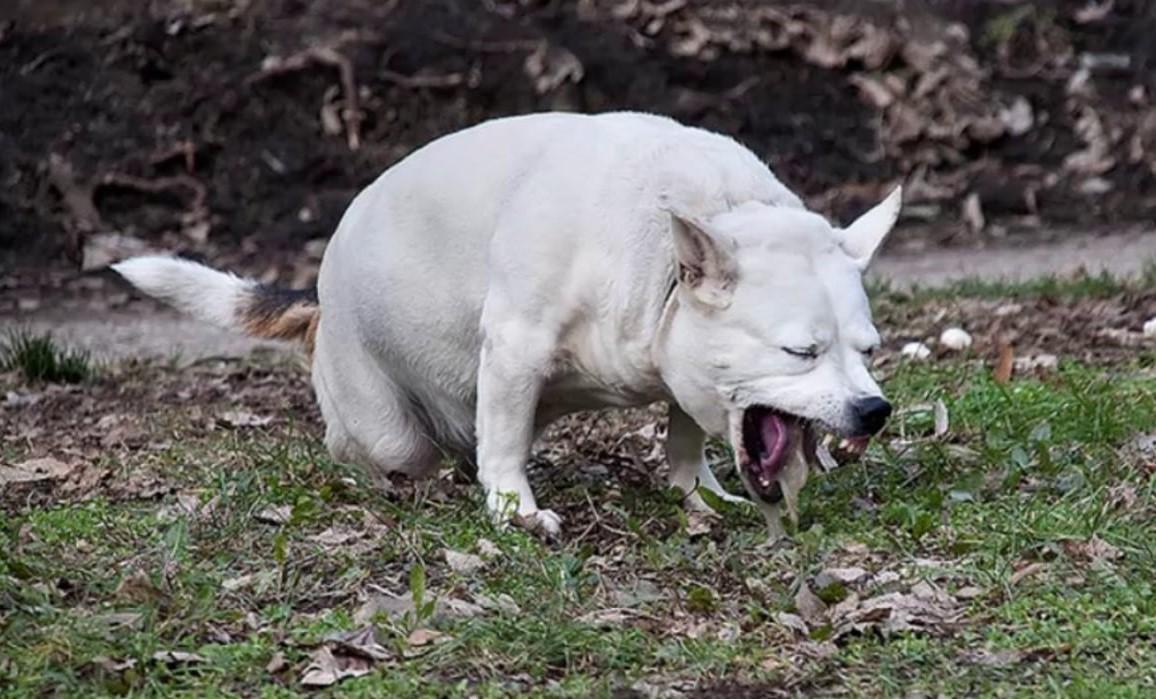How to make a dog vomit
Making a dog vomit can come in handy in certain situations, especially when he has swallowed something he should never have eaten
Nevertheless, it is a delicate maneuver, which should not be carried out wrongly or it will worsen the health situation of the animal. Today, we tell you more about when and how to make a dog vomit, and in which cases this maneuver should not be attempted.
What is the purpose of making a dog vomit?
Vomiting is a natural defense reflex of the body that allows the evacuation of an irritating substance from the stomach. In fact, unlike regurgitation, vomiting is controlled and occurs after an effort resulting in a contraction of the diaphragm.
This phenomenon is often preceded by nausea, the symptoms of which are discreet in dogs, but which an attentive owner can notice by observing hypersalivation that causes the dog to drool or to swallow and lick his lips regularly. In some cases, the ingestion of a foreign body or toxin may not cause the dog to vomit, in which case the owner may want to trigger this defense mechanism to force the animal to expel what it has swallowed.
The goal is to force the dog to expel a foreign body that, if it continues to travel through the dog's digestive tract, may cause damage to various organs (especially the intestine) or a toxin that will have less time to spread through the body if it is quickly expelled. However, this maneuver is only effective in certain cases, when the dog has just swallowed the dangerous object or substance, and when the vomiting does not pose a health risk to the dog.
When not to make a dog vomit?
Before telling you more about the method and the right moment to make your dog vomit, it is necessary to stop on the situations in which it is strictly forbidden to make your pet vomit, under penalty of worsening its case. Timing is particularly important, and you should not attempt to make your dog vomit after 2 hours from the time of ingestion of the poison or foreign body.
After that time, the toxin has already been assimilated and the foreign body has already gone too far down the digestive tract to be rejected. Attempting to induce vomiting would aggravate the situation by unnecessarily irritating the stomach, making it more permeable to toxins, or by causing strong contractions that could lead to internal injury upon contact with a foreign body.
The type of product ingested in the event of poisoning is also crucial: never try to induce vomiting in a dog that has swallowed a corrosive substance. If you don't know what your dog has ingested, or if you know what it is but don't know if it is a substance that meets the definition of corrosive, don't try to make your dog vomit.
A corrosive substance can cause severe chemical burns. A corrosive substance can cause severe chemical burns, and by passing it through the esophagus and mouth a second time, it can cause even more severe burns. In addition, vomiting can, although rare in dogs, invade the nasopharyngeal cavity (vomiting through the nose), whose mucous membranes are much more fragile than those of the stomach.
Bleach, acid, soda, lime, oven cleaners and drain cleaners are all corrosive. Foaming products (laundry detergents, dishwashing liquids, soap, shower gel, shampoo, etc.) should not be vomited either, as they may cause the animal to lather up.
Indeed, they may foam when expelled by the dog, and could then invade its lungs and cause its death by asphyxiation. For the same reasons, never give a dog a drink after it has swallowed a foaming product. And don't worry if your dog has swallowed any of these substances: most of them are not very toxic, and the biggest risk is choking on the foam.
Keeping your dog away from his water bowl for 24 hours (until the product has been evacuated in the stool) is usually enough to save him. Hydrocarbons (gasoline, diesel, kerosene, motor oil, etc.) should not be vomited by your dog either, otherwise it may cause serious lung problems.
These substances, which are very volatile, tend to evaporate and are then inhaled by the animal. They can cause severe pneumonia and will cause much less damage to your dog if left in its stomach.
If you are having trouble determining whether or not the poison your dog has swallowed is safe to vomit, the best thing to do is to call the Animal Poison Control Center as soon as possible, ideally with the container of poison in front of you to give the caller the best information.
If you do not know what your dog has swallowed, or if you have the slightest doubt, do not try to make him vomit and contact your veterinarian. Finally, never attempt to induce vomiting in a dog that is unconscious, very weak, or experiencing tremors or convulsions.
Again, there is a major risk that he will inhale his vomit and choke, which is far more dangerous than the poison itself. Furthermore, if the animal has already vomited, it is also completely useless, and potentially dangerous, to try to make it vomit again.
If a foreign object has been ingested, vomiting is not recommended. Returning an object to the dog's esophagus can cause serious injury, especially if it is a large object or a wire, which may only come out halfway and would be extremely dangerous to pull on.
The same applies if the swallowed object is sharp or pointed: making your dog vomit in this situation is absolutely forbidden. If a small object is swallowed, it is often less dangerous to let it go through the natural route than to try to make the animal vomit, unless the object in question is dangerous (e.g. batteries).

When to make a dog vomit?
Now that you're an experienced handler, here are the poisoning cases that lend themselves to forced vomiting, and in which vomiting your dog may even save him. You can induce vomiting if you know for sure what your dog has ingested and the toxic substance is not corrosive, volatile or foamy.
For example, rat poison, antifreeze, chocolate, grapes, paracetamol, Xylitol, aspirin, certain plants (oleander, foxglove, etc.) or mushrooms (oyster mushrooms, boletus, etc.) can be vomited without the risk of worsening your dog's condition. Note that medications should be vomited as soon as possible, as they are designed to be absorbed quickly by the body.
Before inducing vomiting, you should make sure your dog is conscious and awake to minimize the risk of choking. You should also make sure your dog has not already vomited, in which case the procedure is unnecessary. Your dog should not show any symptoms. Otherwise, vomiting is no longer useful and, in addition, many toxins have nerve effects that can cause pharyngeal paralysis and lead to choking.
Also, avoid inducing vomiting in a brachycephalic (short-nosed) dog, which is more prone to choking due to its malformed airway, and any dog that usually has breathing and/or swallowing problems.
Finally, it is always highly recommended to contact a veterinarian before making your dog vomit. The latter can validate the procedure and give you precious advice on what to do.
Method to make a dog vomit
To make a long story short, there is only one way to make a dog vomit safely, and it requires the use of hydrogen peroxide, or hydrogen peroxide. If you don't have this product on hand, there is no need to attempt this maneuver, as it could injure or poison your dog.
Putting your fingers in your dog's mouth is not a solution. Not only does this method not work in dogs, but you are also exposing yourself to the risk of biting your dog, and you could injure him. Making your dog drink salt water does not work either, contrary to a persistent legend. Moreover, an excess of salt in dogs can cause nerve damage, rapid dehydration, and ultimately coma and death. 40 grams of salt is enough to kill a 10 kg dog!
Once upon a time, Ipecac syrup was used as an emetic in humans and, by extension, in dogs. This substance, which is now banned from sale, is no longer indicated for either dog or human, as it causes severe irritation to the digestive system.
Hydrogen peroxide diluted to 3% is the only safe substance you can give your dog to make him vomit. If you don't have any, you can eventually run to a drugstore or supermarket and buy some, sometimes under the name of hydrogen peroxide.
Never use hydrogen peroxide diluted to less than 3%, otherwise you risk poisoning your pet. Use a syringe without needle to dose the liquid: it is advisable to distribute to your dog 1 to 2 ml per kg of body weight. You can also use a tablespoon (15 ml) for a dog weighing 7 to 15 kg.
Once you have given your dog this mixture (it can be mixed with a little milk to make it easier), it is recommended that you walk your dog to speed up the process. Vomiting should occur quickly, 2 to 5 minutes after ingesting the oxygen peroxide. If the dog has not vomited within 15 minutes, you can give half the initial dose, i.e. 0.5 to 1ml per kg.
Never give hydrogen peroxide to your dog a third time, as this may cause intoxication. If the animal still does not vomit, take him to the veterinarian.

FAQ
My dog has swallowed poison, can I make him vomit?
It depends on the nature of the poison and the timing. You can only try to make your dog vomit if you are sure that he has not swallowed a corrosive, foaming or volatile product, and this within 2 hours of ingestion. For example, chocolate, antifreeze, paracetamol and rat poison can be vomited, but not bleach, lye, motor oil or lye.
Can I give my dog salt water to make him vomit?
No, salt water does not work to make a dog vomit, and too much salt in the dog's system will be just as toxic to the animal. Only hydrogen peroxide is indicated to make a dog vomit.
Can I make my dog vomit by putting my fingers in his mouth?
No, this method does not work to make a dog vomit. In addition to the risk of hurting your dog, you are also exposing yourself to the risk of being bitten.
Where to find hydrogen peroxide to make a dog vomit?
Hydrogen peroxide can be found in supermarkets and pharmacies. Only hydrogen peroxide diluted at 3% is indicated to make a dog vomit without danger. Making your dog vomit can be very useful to save his life and limit the damage caused by certain poisons. Nevertheless, it is not recommended to attempt this maneuver without the advice of a veterinarian.
If you think your dog has swallowed a toxin, your first instinct should be to contact a veterinarian or the Animal Poison Control Center, which will tell you what to do depending on your dog's health and the substance ingested.

